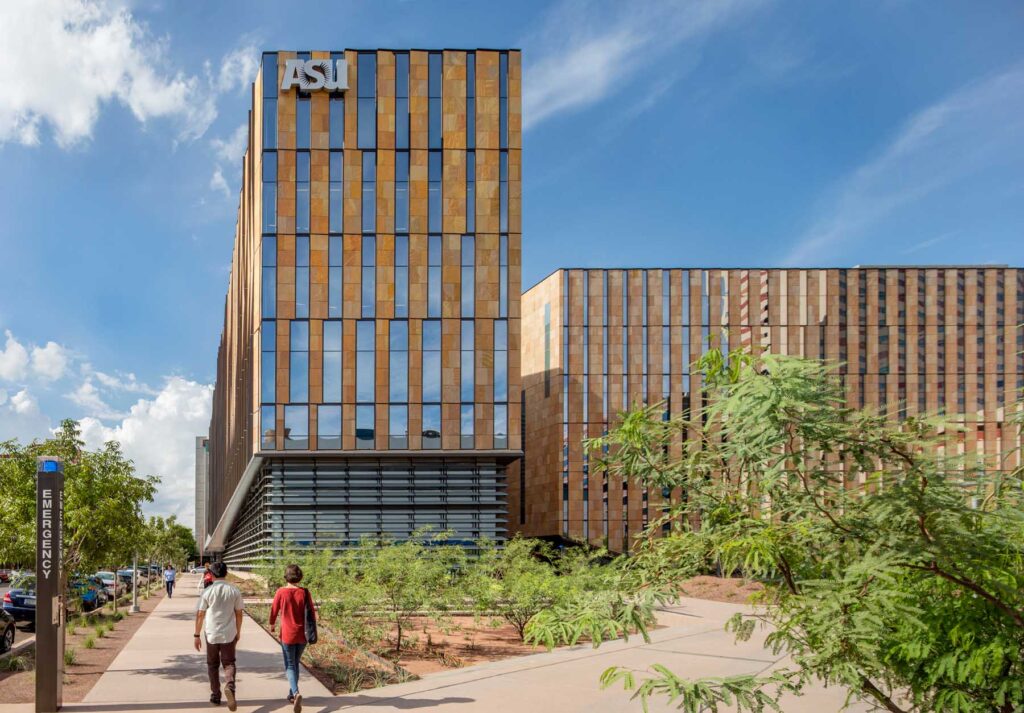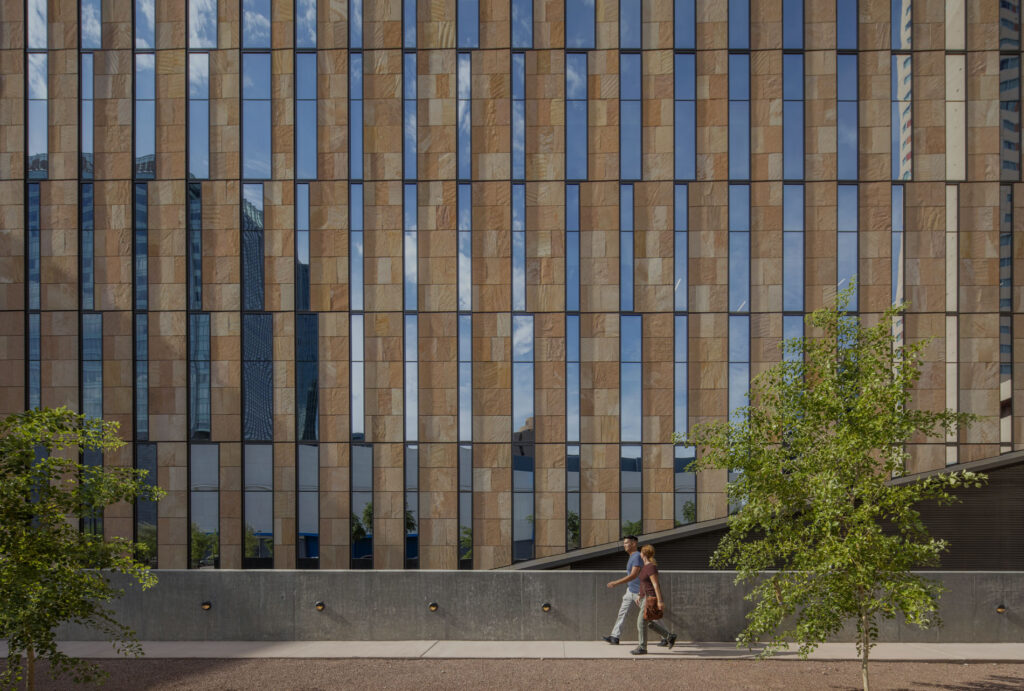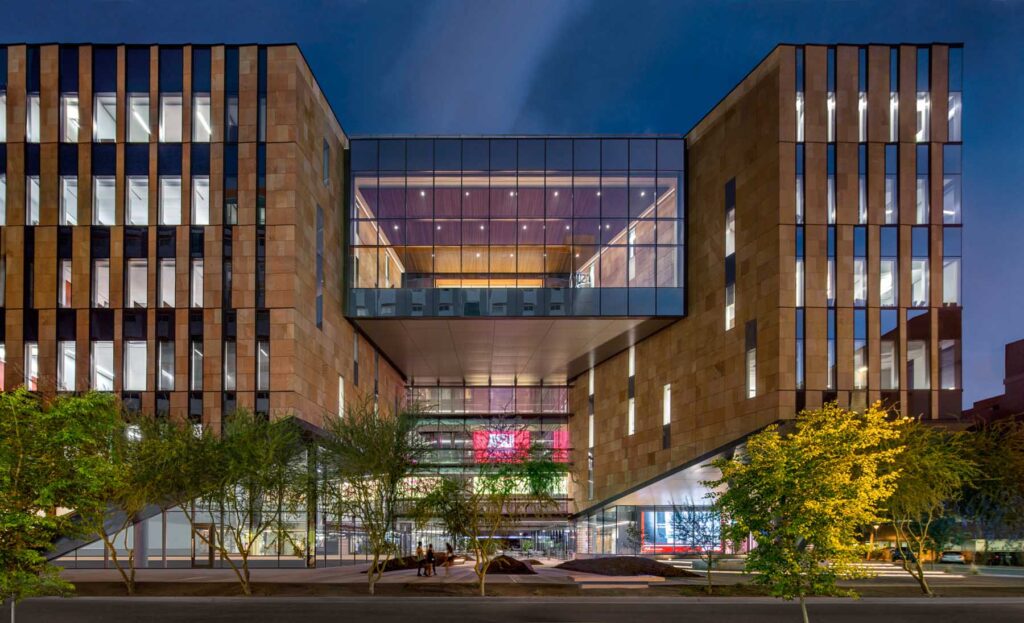ASU Beus Center for Law and Society: A classic example of Kovach’s Strength in Innovation
The true sign of intelligence is not knowledge but imagination
~Albert Einstein
The Beus Center for Law and Society was completed in 2016 for Arizona State University. Jones Studio and Ennead Architects designed the project with DPR acting as the general contractor.
This project stands out in Kovach’s 50 year portfolio as one of the most gratifying and unique projects we have ever completed. Ever since our inception half a century ago we have been known as an innovative team and ASU gave us the opportunity to expand our imagination at every turn.
The design intent for the skin was to clad the exterior with a stone façade that was code compliant, fully warranted and would be durable enough to last a century. An aggressive schedule and working in downtown Phoenix required creative logistical solutions. Glass curtain wall, aluminum fins, and metal panels were also specified as part of the exterior scope.
Challenging situations like this are what Kovach has built our reputation on.

Innovation in Systems
To meet the unique demands of this project our team designed a unitized façade system that captured it all – stone, glass, and metal fins. To secure the stone into the units our engineering team designed a frame that attached to the mullions and a concealed anchor system secured the stone to the frame. The system allowed glazing to be installed in the same plane, while the stone could be articulated in a sawtooth pattern. The male-female joinery of the unitized panels allowed the designer the freedom to alternate between slot glass and stone panels, as well as incorporate architectural fins on the east and west elevations of the building.
We backed the stone panels with a pre-tested insulated metal panel thereby eliminating the need for waterproof, fire, sheathing and insulation testing.

Innovation in Supply Chain
Typically 2 ¼ inch thick stone is used in exterior cladding, however, due to the thickness and sheer weight a thinner, lighter, stone was needed for our system. In addition to dimension constraints, the stone needed to be locally sourced per ASU’s direction. We worked closely with a quarry in northern Arizona to produce sandstone that could be cut to 1 ¼ inch thick. A thinner stone had the dual benefit of being lighter and less costly than typical stone applications.
Thinner stone also meant traditional kerf attachments were not an option. A worldwide search of concealed anchor systems led Kovach to a supplier in Europe where an anchor system was in use that did not create compression points that could crack the stone.
Innovation in Schedule
Commonly a wall assembly this complex requires multiple subcontractors and puts considerable pressure on a project’s schedule. The system Kovach designed consolidated four different scopes into one which not only required less time to fabricate and install but also reduced safety and logistics challenges.
Innovation in Fabrication and Installation
Every wall panel was assembled in our glass fabrication shop where conditions are regulated and tracked every step of the way. Each panel was constructed while laying horizontally at ideal working height, allowing extraordinary safety and quality control. “This is the ultimate in quality control,” according to James Hatch, VP of Preconstruction. “Working safely to assemble the panels at comfortable levels and both feet on the ground ensures a top quality system.”
Because the units were fabricated and assembled at our shop, the installation was safer and required a smaller crew and a smaller staging area. The on-site crew was able to crane the panels from the ground directly to the building, virtually eliminating the need for scaffolding. This not only greatly reduced the risk of injury on the job site and maximized manpower, but it provided much-needed space for the congested job site.
Innovation in Testing
Using a thinner stone in a system that had not been used before begged the question “Would it last a minimum of the targeted 100 years?”
In addition to the standard strength and rupture tests (ASTM C1751, C97, C99, C170, and C1352) required for stone facades, this unique system underwent an accelerated weathering test. ASTM C 880 is a flexural strength loss test that simulates how the stone’s strength will be affected over time. These test results were critical to providing the owner with assurance that the system was sure to perform for a minimum of 100 years.
Perhaps James Hatch summarized the Beus Center for Law and Society project best:
“We are not afraid to offer a new idea, a new solution. We run toward those jobs. We thrive on innovation while making sure we’re providing the best quality and working safely. Like any project, there were challenges and the first one is always the same: we were on a fairly aggressive schedule. We’re used to that, but we never let quality or safety suffer because of a time crunch.”


